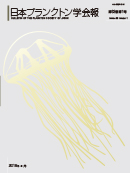63 巻, 1 号
選択された号の論文の16件中1~16を表示しています
- |<
- <
- 1
- >
- >|
原著論文
-
2016 年63 巻1 号 p. 1-7
発行日: 2016/02/25
公開日: 2019/03/13
PDF形式でダウンロード (555K)
総説
-
2016 年63 巻1 号 p. 8-15
発行日: 2016/02/25
公開日: 2019/03/13
PDF形式でダウンロード (684K)
2015年日本プランクトン学会春季シンポジウム
-
2016 年63 巻1 号 p. 16-20
発行日: 2016/02/25
公開日: 2019/03/13
PDF形式でダウンロード (311K)
研究情報
-
2016 年63 巻1 号 p. 21-22
発行日: 2016/02/25
公開日: 2019/03/13
PDF形式でダウンロード (317K) -
2016 年63 巻1 号 p. 22-23
発行日: 2016/02/25
公開日: 2019/03/13
PDF形式でダウンロード (428K) -
2016 年63 巻1 号 p. 23
発行日: 2016/02/25
公開日: 2019/03/13
PDF形式でダウンロード (420K) -
2016 年63 巻1 号 p. 24-25
発行日: 2016/02/25
公開日: 2019/03/13
PDF形式でダウンロード (480K) -
2016 年63 巻1 号 p. 25
発行日: 2016/02/25
公開日: 2019/03/13
PDF形式でダウンロード (474K) -
2016 年63 巻1 号 p. 26
発行日: 2016/02/25
公開日: 2019/03/13
PDF形式でダウンロード (319K) -
2016 年63 巻1 号 p. 27-28
発行日: 2016/02/25
公開日: 2019/03/13
PDF形式でダウンロード (326K)
受賞記事
-
2016 年63 巻1 号 p. 29
発行日: 2016/02/25
公開日: 2019/03/13
PDF形式でダウンロード (189K) -
2016 年63 巻1 号 p. 30
発行日: 2016/02/25
公開日: 2019/03/13
PDF形式でダウンロード (280K)
書評
-
2016 年63 巻1 号 p. 31
発行日: 2016/02/25
公開日: 2019/03/13
PDF形式でダウンロード (218K) -
2016 年63 巻1 号 p. 32
発行日: 2016/02/25
公開日: 2019/03/13
PDF形式でダウンロード (214K) -
2016 年63 巻1 号 p. 33
発行日: 2016/02/25
公開日: 2019/03/13
PDF形式でダウンロード (229K)
Plankton and Benthos Research掲載論文要旨
-
2016 年63 巻1 号 p. 34-36
発行日: 2016/02/25
公開日: 2019/03/13
PDF形式でダウンロード (274K)
- |<
- <
- 1
- >
- >|
